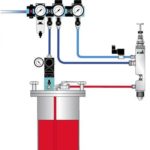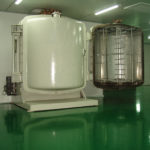Painting on metal surface requires necessary pretreatment in order to achieve the best finishing. Among the various solutions, phosphating is the most popular choice for mass production. Phosphating or phosphate conversion is a process of chemical treatment over metal part. The chemical conversion on metal surface provides a protective layer which is uniform and inert to the environment. Phosphate process includes zinc phosphate, iron phosphate, chromate, or manganese phosphate.
Benefits of the phosphate treatment include:
- better adhesion for post processes like powder coating paint
- improved corrosion resistance
- surface that is tightly bonded to the base metal.
Phosphating can be performed on ferrous (iron, steel based) and non-ferrous surfaces (zinc, chrome, aluminum, and manganese).
Wash and Phosphating
Phosphate wash is properly preparing the parts by cleaning residues left from prior processes like welding, grinding, and drawing residues such as machining oils, grease, dust, and rust and then iron phosphating. This is commonly achieved in a multistage alkaline cleaning, rinsing, phosphating, and rinsing immersion tanks or spraying system. Iron phosphate can sometimes combine washing/cleaning with phosphating depending on initial part cleanliness.
Phosphating Process Controls
Controlling the phosphating process is essential to achieving consistent coatings which ultimately result in a stable coating process. The most important process controls in phosphate conversion are:
- Time – The longer the contact time, the more time to chemically react. The process must be long enough to allow the chemistry to form a uniform coating.
- Temperature – Chemistries typically become more aggressive at elevated temperatures.
- Concentration and pH – The more acid in concentration accelerates the coating process and can result in a heavier total weight of the coating.
Types of Phosphating
Iron phosphate- the most common pretreatment for powder coating because it can be used with almost any material and has more environmentally friendly by-products or sludge. This process is commonly used on steel materials.
Zinc phosphate- a non-metallic, crystalline coating that is extremely adherent to materials. It is important to note that the zinc phosphate coating results from the solution itself, not from the part surface like an iron phosphate coating. Zinc phosphate crystals start forming at anodic surfaces on the part surface and stop forming when the part surface area is consumed, ie. they hit another crystal.
Unlike iron phosphate, zinc phosphate cannot clean and coat at the same time; therefore, a four-stage wash, rinse, zinc phosphate, rinse is a common setup. While zinc phosphating provides improved coating adhesion properties, better coating in tight areas and better corrosion resistance, the process has higher operating costs, uses heavy metals, and can produce considerable sludge, none of which is environmentally friendly for disposal purposes. Zinc phosphate is typically used on galvanized steel materials.
Chromium phosphate- most commonly used for aluminum alloy based parts. While this process is effective, like zinc phosphate, it uses heavy metals which need to be recovered for environmentally friendly disposal.




